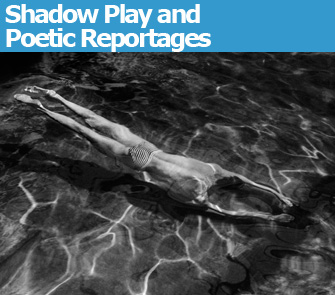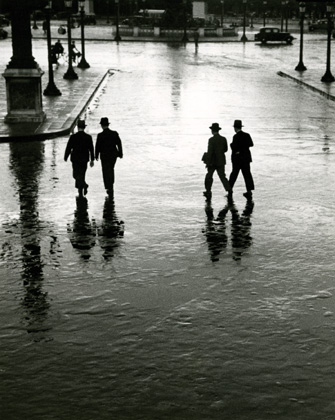|
|
|
“Underwater Swimmer, Esztergom” (1917) by André Kertész. Gelatin silver print. Bibliothèque Nationale de France.
|
If there had been no André Kertész (1894-1985), would there have been a Brassaï, a Henri Cartier-Bresson, a Robert Doisneau, a Willy Ronis? Kertész the precursor did it all …
 |
|
“Underwater Swimmer, Esztergom” (1917) by André Kertész. Gelatin silver print. Bibliothèque Nationale de France.
|
If there had been no André Kertész (1894-1985), would there have been a Brassaï, a Henri Cartier-Bresson, a Robert Doisneau, a Willy Ronis? Kertész the precursor did it all before them: shooting from oblique angles; cropping images in unconventional ways; shooting at night; using mirror images, reflections and shadows; and capturing what Cartier-Bresson later called the “decisive moment.”
The current retrospective at the Jeu de Paume offers a rare chance to see a large collection of Kertész’s original prints, plus many published images. The show starts with contact prints made when Kertész was in his 20s. While some of these are so small that it is difficult to make out details, even with the pretty much useless plastic magnifiers the museum lends visitors (better to bring your own), Kertész’s perceptive eye, curiosity, sense of humor, poetic sensibility and eagerness to experiment are already very much in evidence in such images as “My Brother as a Scherzo” (1919), in which the photographer’s sibling Jenö is caught in silhouette against the sky in a midair leap à la Nijinsky or another of a stretched-out Jenö swimming underwater (pictured above), a great innovation in its time. Others, like “Esztergan” (1918), which shows just a house and a tree on a hillside framed against the sky, have that moody, mysterious sense of absence that will reappear in so many of Kertész’s later images.
Born in Hungary, Kertész fought for the Austro-Hungarian Army in World War I, during which he was seriously wounded but continued to take pictures, of his friends and fellow soldiers rather than the gory details of war.
His work matured after he moved to Paris in 1925. At first he associated mainly with the émigré community of artists since he didn’t speak French, but he quickly became well-known as an avant-garde photographer. He was given his first gallery show only three years after his arrival and also began to work for magazines and newspapers.
While Kertész always eschewed the idea of pure reportage except when he was on a specific assignment for a magazine, he is credited with unintentionally creating the “photoreportage,” in which a photographer covers a subject from a personal rather than objective point of view (Life magazine once rejected one of his photoreportages because it “talked too much”).
The Paris years were a highlight for Kertész. This is when he took many of his iconic pictures, including “Satiric Dancer” (1926), of a woman in a dancer’s angular pose stretched out on a sofa; a portrait of Piet Mondrian that does not include the painter, just two pairs of eyeglasses and his pipe; the entrance to Mondrian’s studio, with its staircase, flower vase and hat hanging on the wall; a fork resting on the edge of a plate, casting strong shadows; the Eiffel Tower at night surrounded by lightning bolts; and so on.
Among those from this period that I loved were “Square Jolivet at Night” (1927) taken from above at an oblique angle, with circular patterns formed by the shadows of the streetlamp and stripes by the shadows of the benches; two sets
 |
|
André Kertész: “Place de la Concorde, Paris” (1928). Gelatin silver print. Robert Gurbo collection. |
of men in silhouette crossing a rain-soaked Place de la Concorde; and “Rue des Ursins” (1931), in which the gracefully curving street separates two glimpses of contrasting lifestyles: on the left, a nun with her little black dog (or perhaps a cat), and on the right, two men and a little white dog seen through the door of a bar. One series I liked less was the photographer’s “Distortions,” images of nude women reflected in funhouse mirrors, which seemed too gimmicky.
Times were tougher for Kertész and his wife, Elisabeth, after they moved to New York in 1936. In 1947, he got a day job photographing interiors for the magazine House and Garden, work he considered “slavery.” It was only after he retired from this job in 1962 that Kertész was once again able to take joy in photography. His New York photos capture the stony urbanity of the city just as his Paris photos had caught the particular charms of the City of Light. Kertész always pitted New York’s hard, straight lines against something soft or alive: a pigeon in flight against a brick wall, or a single, delicate cloud defying the hard, rectilinear mass of Rockefeller Center (“Lost Cloud,” 1937).
Kertész’s influence was so great that when most of us take a picture today, we are unconsciously imitating him or one of his followers, while professional photographers have to constantly strive to find new, original ways to express themselves without imitating their forebears, which today usually means using technical innovations. But even though Kertész long ago set the standard for so much that came later, much of his work still looks modern, quirky and original today.
Jeu de Paume: 1, place de la Concorde, 75008 Paris. Métro: Concorde. Open Tuesday, noon-9pm; Wednesday-Friday, noon-7pm; Saturday-Sunday, 10am-7pm. Admission: €7. Through February 6, 2010. www.jeudepaume.org
Reader Richard Ewen writes: “I enjoyed reading your article on Kertesz. His photography has influenced my cropping of composition in my still-life paintings along with other important, well-established photographers. I was exposed to his and other great photographers through the Getty collection in Los Angeles and many photography shows in Paris. It is always dicey to comment on one artist’s influence on another, but the lead photograph you have shown in your article certainly may have influenced David Hockney’s pool paintings on the 1960-70s.”
Reader Reaction: Click here to respond to this article (your response may be published on this page and is subject to editing).
Order books on André Kertész from Paris Update’s Amazon store at no extra cost. Click on your preferred Amazon location: U.K., France, U.S.
Support Paris Update by ordering books from Paris Update’s Amazon store at no extra cost. Click on your preferred Amazon location: U.K., France, U.S.
More reviews of Paris art shows.
© 2010 Paris Update
Favorite